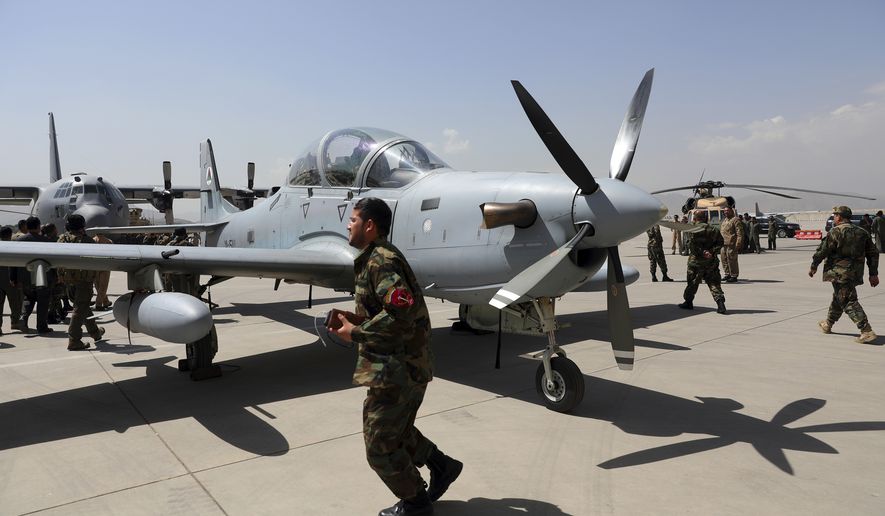The U.S. government’s lead Afghan watchdog agency warned the Pentagon that the country’s fledgling air force was on the verge of collapse without an influx of American assistance, months before the last American troops withdrew from Afghanistan at the order of President Biden and the Taliban surged to power.
The Special Inspector General for Afghanistan Reconstruction, which has produced a long string of critical audits of the 20-year U.S. war effort and reconstruction plan, filed the pessimistic report with the Department of Defense in January 2021. The declassified version of the report was released this week.
According to the report from Inspector General John Sopko, the Afghan Air Force under the control of the U.S.-backed government in Kabul struggled with a number of issues, including recruiting challenges and maintenance issues, despite the U.S. pumping $8.5 billion into building up the force.
The SIGAR report said the Afghan Air Force and its elite unit, the Special Mission Wing, were woefully unprepared to take on the Taliban forces on their own. The Taliban swept to power in a lightning advance that ended in August 2021 with the capture of Kabul, even as Afghan military services effectively melted away.
“Sustainability requires the recruitment, training and retention of qualified personnel in all areas of the air forces — including pilots, maintainers and personnel in support positions,” according to the report. “The [Afghan Air Force] and [Special Mission Wing] have not met authorized personnel levels to fulfill their increased mission requirements.”
The Afghan Air Force, the report stated, did not have a recruiting strategy to find enough personnel to carry out its mission. One of the problems, Pentagon officials told the SIGAR investigators, was the “high recruiting standards” and competition with other Afghan military units for personnel.
“Neither [the Department of Defense] nor the Afghan air forces have prioritized the training or development of personnel in support positions,” Mr. Sopko wrote in the report. “Furthermore [the Pentagon] does not ensure qualified and trained pilots and maintainers are in positions that utilize their advanced training.”
Defense Department officials said they were aware of the concerns identified in the SIGAR report, and contended the auditors’ findings are “actively addressed” by the Pentagon and U.S. military officials in Afghanistan at the time.
“It was an air force that we and our coalition partners helped make much more capable. They were flying the majority of missions in support of their troops on the ground,” chief Pentagon spokesman John Kirby told reporters on Tuesday. “They had capabilities far more advanced than they had ever had before.”
The U.S. mission in Afghanistan also relied heavily on civilian contractors to provide crucial support to the now-former Afghan Air Force — including mentoring and training in a variety of crucial areas such as logistics, engineering, air-to-ground integration and aircrew training. The SIGAR reported noted that the Pentagon’s reliance on contractors posed “operational challenges and risks” along with the potential for waste.
“The potential withdrawal of contractors from Afghanistan, in addition to U.S. and coalition forces, may leave the [Afghan Air Force] and [Special Mission Wing] without the necessary support to sustain and develop the Afghan air forces, if alternative sources are not identified,” the report stated.
It is estimated that the U.S. government and military spent over $1.1 trillion dollars over two decades fighting the war in Afghanistan, trying to build up the local military forces and aiding economic reconstruction in the country. The new SIGAR report estimated that the U.S. spent some $8.5 billion “to support and develop” the Afghan air force alone in the years from 2010 to 2019.
Pentagon officials insisted they intended to continue backing the Afghan Air Force even after U.S. troops left the country through an “over-the-horizon” logistics support mission.
“We absolutely recognized the shortcomings and issues that the Special Inspector General made back in January 2021,” Mr. Kirby said. “We were addressing those and we made it very clear that we were going to continue to try to find ways to make the Afghan Air Force even better.”
But that plan became moot with the Taliban takeover in August.
• Mike Glenn can be reached at mglenn@washingtontimes.com.




Please read our comment policy before commenting.